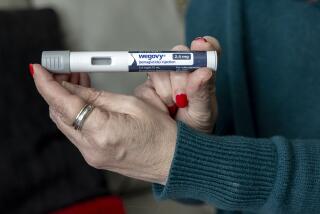Therapy Shows Promise in Blocking Onset of Diabetes : Health: Preliminary studies suggest potent drug may prevent or delay for years the Type I form of the disease.
Diabetes specialists around the country are beginning human trials of a new treatment that may be the most important advance in the disease since the advent of insulin therapy.
For the first time, physicians are identifying youths who are at high risk of developing juvenile-onset diabetes and treating them in hopes of preventing--or at least delaying for many years--the onset of the disease.
In the most promising of the trials, physicians are treating the prospective diabetics with a potent drug that suppresses the immune system. Preliminary data suggests that, in many cases, this will halt the “autoimmune” attack on the pancreas that causes the disease.
The stakes are high. Between 750,000 and 1 million Americans suffer from juvenile-onset diabetes, also known as insulin-dependent or Type I diabetes, according to the American Diabetes Assn., and 13,000 to 15,000 new cases are diagnosed each year. Most people contract Type I diabetes during childhood, but a small percentage develop it as adults.
Although insulin injections can control the overt symptoms--such as excessive thirst, urination and coma--most diabetics eventually develop serious complications, including kidney damage, nerve damage in the arms and legs and vision loss. Treatment for diabetes and its complications costs the United States about $20.4 billion each year.
Even if the new therapy could only delay the onset of diabetes, it would offer patients several more years of life free of these disabling complications. And should it prevent the disease, the patients would be free of those complications indefinitely, researchers say, although they would have to undergo the new therapy for the rest of their lives.
“This is an extraordinarily promising avenue for study,” said Robert E. Silverman, head of the diabetes branch at the National Institute of Diabetes and Digestive and Kidney Diseases in Bethesda, Md. “I don’t want to overstate its significance, but this could really be hot stuff.”
The trials, to be conducted at the University of Florida Health Science Center, the Joslin Diabetes Center at Harvard Medical School, Denver Children’s Hospital and the University of Washington in Seattle, represent “an exciting possibility,” added Richard Kahn, medical director of the American Diabetes Assn.
The new therapy has been found effective in extensive studies on laboratory animals. The best evidence that it will work in humans is seen in the experience of Peggy Polopolus, 21, who began the therapy in a pilot project five years ago. At that time, physicians at the University of Florida Health Science Center predicted she would develop Type I diabetes within six months. She still has not contracted the disease.
Polopolus is being treated with a powerful drug called Imuran. The drug suppresses the immune system in much the same way it does to prevent the rejection of transplanted organs.
Researchers caution that little is known about Imuran’s long-term effects, but they are enthusiastic about its prospects. “If it (the therapy) works, a child of 10 might be on it for 60 years, and that’s a long time,” Kahn said. “We don’t know what the drug will do to them, but we do know what is going to happen to them if they develop diabetes, and that could be much worse.”
The new approach to therapy is based on the growing recognition that Type I diabetes is an autoimmune disease in which the body attacks its own tissues--in this case, the insulin-secreting beta cells of the pancreas.
Insulin helps most of the body’s cells take up biological fuels, especially the sugar glucose. In the absence of insulin, the glucose accumulates to high levels in the blood. Then the kidneys overwork themselves to filter excess glucose into urine.
Meanwhile, body cells starve in a sea of plenty, and thus must break down their own stores of fat and protein for energy. During this breakdown, acidic byproducts called ketones build up in the blood. Combined with the dehydration, these ketones induce coma and death.
Type I diabetes can be treated with daily injections of insulin. These allow the patients to live a predominantly normal life. But because the injections are given only two to four times per day, at most, levels of glucose in the blood vary widely, and these variations are thought to cause the complications of diabetes.
Scientists do not yet know why the immune system attacks the beta cells, but both genetics and viral infections are thought to be involved.
Diabetes specialists once thought that the destruction of the beta cells was a fairly rapid process, occurring perhaps over a matter of a few months. Now, however, it is clear that the process can take as long as seven years, and that the onset of diabetes itself does not occur until at least 80% of the beta cells in the pancreas have been destroyed.
Hence, if that destructive process can be detected, it might be possible to arrest it before too much damage is done.
The key seems to lie in certain antibodies whose normal function is to fight disease; diabetes victims, however, are plagued with antibodies that attack their own bodies. In the last 15 years, researchers have discovered three different antibodies that can indicate destruction of beta cells:
* Islet-cell autoantibody is thought to be directed against a fat molecule found in the interior of islet cells.
* Antibodies against insulin, present in virtually all patients who have received insulin therapy, are believed to exist years before the onset of disease.
* The most recently identified and potentially most important antibody works against an unidentified protein, 64-K, which appears to be present in only the membrane of beta cells. Pathologist Mark A. Atkinson of the University of Florida has found that this antibody can be detected in humans as many as seven years before diabetes symptoms occur.
If elevated concentrations of all three antibodies are present in a person’s blood, Kahn said, then “it’s a virtual certainty that person will develop diabetes within three years.”
For several years, researchers at various medical centers have been treating newly diagnosed type I diabetics with the immune-suppressing drug cyclosporine--the same drug that has revolutionized organ transplants during the last decade--in an effort to retard development of the disease. The treatments typically delay the patient’s need for insulin from six months to two years, but no longer.
“The problem is that by the time these patients had symptoms of diabetes, they had lost most of their insulin-producing islet cells,” said Florida endocrinologist William Riley. Furthermore, cyclosporine has a number of serious side effects, including liver damage and an increased incidence of cancer.
In an article in the current issue of the journal Diabetes Care, endocrinologist Rebecca Lipton and her colleagues at the University of Pittsburgh conclude that the benefits from such therapy are too low to justify the risk. “Further use of the immuno-suppressive agent cyclosporine cannot be justified,” they wrote.
The approach must therefore be to treat children before they actually develop the symptoms of diabetes and to use a drug that has fewer side effects than cyclosporine, said Florida pathologist Noel Maclaren.
The tests for antibodies identify potential diabetics, and the drug of choice is Imuran, which has been used for a quarter-century as an anti-rejection drug and for a somewhat shorter time as a treatment for rheumatoid arthritis. It is less effective than cyclosporine at blocking rejection, but it has fewer side effects.
Peggy Polopolus, who now works for an advertising agency in New York City, was the first patient Riley and Maclaren treated with Imuran. Peggy was 14 when her younger sister, Eleni, developed Type I diabetes. The Florida researchers were then screening large numbers of diabetics’ relatives to study the reliability of antibody testing. They found that islet cell autoantibodies were present in Peggy, but at low levels.
Because her grandfather had also had Type I diabetes and two aunts had the less-severe but more common form of diabetes known as Type II, the researchers continued watching her. (Type I diabetes has long been known to run in families. Siblings of diabetes patients have as much as an 11% risk of developing the condition--much higher than the overall population risk of 16 cases per 100,000.)
About a year later, her blood-sugar levels starting climbing and her insulin levels started falling. Riley put her on Imuran, and she has been taking two 50-milligram tablets every day since.
Polopolus said the Imuran therapy has not had any adverse effects on her. “I’ve had colds every once in a while, but I was prone to getting colds anyway.” She did develop mononucleosis during college, but Riley believes that was unrelated to Imuran use.
Most important, her blood-sugar level, which was above normal when she began the regimen, dropped back into the normal range and has stayed there ever since. Polopolus believes she has been “incredibly lucky” to be spared the insulin injections that her sister must take.
Riley, Maclaren and their colleagues treated one other patient, an 8-year-old girl who had more beta-cell damage than Polopolus when she began the therapy. The onset of her disease was delayed for four years. After beginning her therapy, however, the researchers decided not to treat any more patients until they had accumulated more information on the predictive value of the antibodies.
“We were too far ahead of ourselves,” Riley said. “We couldn’t convince other people we had the data.”
Now, based on several studies in which Imuran prevented development of diabetes in rodents, they believe they have the data, and other researchers agree. In April, the National Institute of Diabetes and Digestive and Kidney Diseases convened in Washington to consider theirs and other research. That conference concluded that the time was ripe to begin wider clinical trials.
Researchers at the four medical centers plan to screen 8,000 to 10,000 close relatives of patients with Type I diabetes. The initial screening will be for islet cell autoantibodies. Individuals who test positive will then be studied for insulin antibodies and impaired insulin secretion. Those who test positive for these characteristics will be enrolled in the study. Those who do not will be re-examined every six months.
As many as 80% of those who are positive for these tests are expected to develop diabetes within five years without treatment. The accuracy could be improved, Riley said, if they tested for anti-64-K antibodies, but that test is still too expensive and cumbersome. But he predicts it will be used within a year or so.
From this testing, the four centers expect to identify 75 to 80 children who are at high risk. These will be treated with Imuran and monitored for as long as necessary. The first patient identified began Imuran treatment in Florida four weeks ago.
Meanwhile, researchers at Harvard are attempting a different approach. Tests in animals have shown that administering insulin to potential diabetics before the pancreas is severely damaged can interfere with the immune attack, even block it completely. During the therapy, called “beta-cell rest,” the pancreas sharply reduces its insulin production. Furthermore, the proteins on the surface of beta cells that are attacked by the immune system disappear, halting the attack, said Harvard endocrinologist Richard Jackson.
Two children have so far been enrolled in the study--16-year-old Sean Finley of Alexandria, La., and 9-year-old John Moore of Indianapolis. Each takes two doses of insulin per day that total about one-quarter the normal daily dose for a diabetic. Every nine months, they fly to Boston for a week of intensive intravenous insulin therapy that attempts to shut off the pancreas completely.
The hope is that, even though the boys have to take insulin daily, the pancreas will continue to function well enough to prevent the wide swings in blood-sugar concentration that cause the complications of diabetes. Sean has been in the program 18 months and John for 12 months with no apparent decline in pancreatic function. Each was expected to develop diabetes within three years of diagnosis, so it is too soon to tell if the treatment is successful.
The Harvard group hopes to enroll three to five more patients in the trial, but endocrinologist George Eisenbarth conceded that most pre-diabetics the group identifies will be enrolled in the Imuran trial because it seems more promising.
If the clinical trials prove successful, the next stage will expand the procedure to larger population groups. Even though relatives of diabetics have a high risk of developing the disease, they nonetheless represent a small minority of all Type I diabetes victims.
Eventually, the entire population under age 25 would have to be screened, an exceptionally daunting prospect. And because the age of onset varies, children would have to be screened periodically in order to detect the first signs.
That task would be simplified if researchers could identify a gene that would be highly predictive of diabetes risk. But that possibility is in the distant future, and researchers are now concentrating only on the first stages. The therapies, Maclaren said, “are certainly going to work. The questions we are going to have to settle are for how long, how well and at what cost?”
“And even if we are only able to delay onset for a number of years,” added endocrinologist David M. Kipnis of Washington University in St. Louis, “that’s a real accomplishment.”






